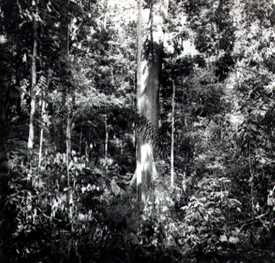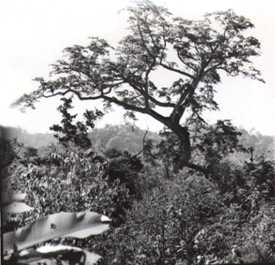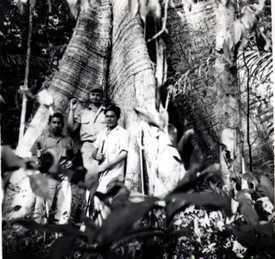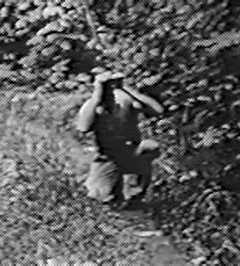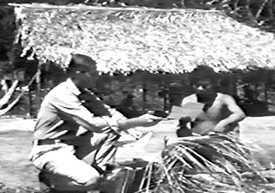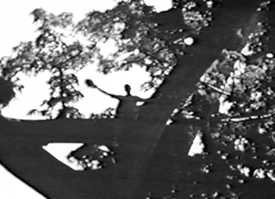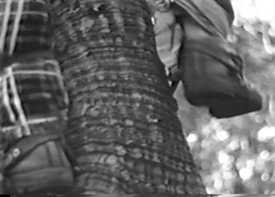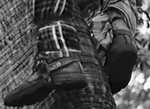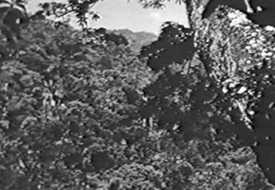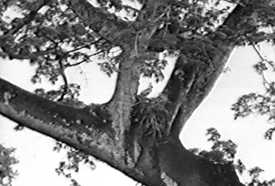The Nest is Found
by Jim Fowler
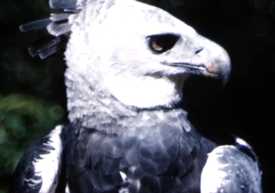 |
Let's see, I ended "Quest for the Nest: Part 2" this way....
"So it was just me and Manuel. Curious Manuel. We moved down the main trail and when it ended followed a smaller trail. And when the foliage thickened we hacked our way through it. Manuel had a machete. I had a Malaysian parang. One mile, two miles, three. It was slow going. It was hot. It was buggy. But we were on the trail of the Harpy eagle and my adrenaline was pumping."
Okay.... I found Manuel to be very skilled in the forest. A five-foot tall, bemuscled dynamo who made every machete blow count. "We are very close," he finally said. (He had been at work in this area - sawing trees - when he heard the call and caught a glimpse of the bird that was in my pictures.) So I really concentrated on my surroundings, now. Listened intently. Hoping that the next sound I'd hear would be that of the Harpy eagle. Luckily, there was still plenty of daylight left.
The forest was alive. Activity everywhere. Yanky birds calling - whistling like "macho men" do when there's a pretty girl in the vicinity. And Bell birds - chiming in with their "clanging" call. There were the sounds of cicadas, monkeys, a whole horde of animals and insects creating a din that I found very calming. When birds are singing, there isn't a big snake or a jaguar around.
Finally, it happened. The unmistakable call of an eagle. At that time, the language of the Harpy eagle was relatively unknown, but I remembered hearing that same kind of sound issue from an immature (one-eyed) eagle back in Florida years before. Very high-pitched - a kind of begging sound that reminded me of a whistle screaming plaintively. But it was very far away. Very faint.
I signaled Manuel that we must quickly hide and he disappeared in an instant. We waited. And waited. Almost two hours later we again heard the call and sure enough, there it was. We finally saw an eagle through an opening in the forest canopy. An immature Harpy eagle. How did I know that it was an immature Harpy? Well, it was very light colored. The backs of adult Harpy eagles are much darker, almost slate black. And their fronts are very white. No, this was a young Harpy, all right. It didn't "hang out" for very long, however, but I'll never forget seeing it for the first time. It appeared from nowhere, rode the thermals - kind of floated a few seconds - then disappeared from sight. It was still daylight, but there was very little sunlight because the canopy of majestic trees was so thick. Fortunately, there was an opening large enough that we could see some blue sky and bits of clouds. It was against that backdrop that the Harpy revealed itself.
Manuel pointed to a tree at the rim of the opening. It was his belief that this was the tree that held the nest. I was ecstatic. I couldn't believe my good luck. But it would be twilight soon and we had miles to go before reaching camp. I decided that we should get out of there immediately - get back, retrench and try to make some plans. Manuel, my Macushi Indian friend, lead the way and the trip back seemed much shorter.
|
|
The plan
The next morning I got everybody together. Ram Singh and Jim Cope were back from their own bird exploration. Ivan was there and, of course, Manuel. After a lot of discussion we decided that it would be best to approach the tree at night. That way, I wouldn't frighten the immature eagle. For all I knew, it might very well take off and never come back.
So, that's what I did
I began by building a blind about 60 feet from the base of the "nesting" tree. I used mosquito netting, camouflage cloth and transplanted lots of small saplings to form a thick roof over the blind. I slung a hammock inside the blind so I could lie on my back and look out through a hole I made in the top. Not a big hole, just something that allowed me to see some of the big limbs of the trees above me. I must admit, I did a decent job of it. Manuel had difficulty making it out even though it was right on the trail.
I knew that the blind had to be as perfect as possible. Animals know every inch of their home territory. They're suspicious of any little thing that changes. When an animal is in the process of migration, you can make a few mistakes without scaring it away. You'll still be able to observe its activities. There's no room for mistakes when the animal is "at home," however. And when it comes to observing an eagle, well - the eagle's eyesight is probably the most powerful of all of the animals. You have to be especially cautious with an eagle.
I began the process of leaving camp each late evening, trekking to my blind, sleeping in it until morning and remaining hidden in it throughout the day. A week passed. Then two. In that time I didn't have any indication that my Harpy suspected that I was invading its property.
After two weeks, I started expanding my territory a little. Tried out other vantage points - observation posts, I called them - trying to catch a glimpse of my bird. (Or one of its parents.) And I was fairly successful in doing this. I discovered that my immature eagle was in the habit of landing on the top limb of either a dead tree or a Ceiba tree that was losing its leaves. (The Ceiba is the only tree in the rain forest that, at certain times of the year, drops some of its leaves and grows new ones.) That way, it was out in the open and could be seen. And while up there, it usually called out to its parent with that plaintive scream that I had heard so faintly on that first day. A begging scream that no doubt said, "I'm hungry. Please bring home the bacon."
And it did something else while calling. To make sure mom, dad, or both could find it, it did a little wing-flipping thing. First extending its wings, then inverting them toward its chest. This way, the very light, almost white underportion of its wings could be seen from a great distance. Mother Nature is amazing, isn't she? My immature Harpy instinctively knew that it not only had to be out in the open, it had to call out as well as flash a signal if it expected to earn its supper. Unfortunately, I never saw the adult Harpy come to feed its offspring.
I began to feel very comfortable in the forest after several weeks of trying to spot the adult. And there were times when the young one moved off so far away that I had no contact with it. These were the times that I grew impatient. I felt I had to do something; had to find other vantage points where I might see it and learn more about its habits.
I made expeditions to the tops of mountains in the area. They weren't very high - only about 2,500 to 3,000 feet above the ground level of the savanna (which was about 1,500 feet above sea level). But, nevertheless they had some fairly spectacular ridges and were densely covered with undisturbed forests. I tried to get to points where I could look out over the valley and keep watch over my Harpy's territory.
|
|
Now the tree that Manuel had pegged as the "nesting" tree was located very close to a creek that the native population called Nappi. It was an emergent tree. A Ceiba, or silk cotton tree, that's higher than any other tree in the area. (Much later on, after studying quite a few different nest sites, I found that most giant eagles choose Ceiba trees as their nesting trees.) There's another name applied to the Ceiba, or silk cotton tree. Kapok. During WWII, when there wasn't, as yet, material like foam rubber, the military used the Ceiba's cotton in some of its equipment. Military mattresses and life rafts were often stuffed with kapok. Its an enormous tree. Its buttresses are 30 feet in diameter at the base, and they angle another 30 feet before juncturing with the tree's main trunk. A trunk that's about 10 feet in diameter, by the way.
So after several weeks of observing, trying to determine the Harpy's movements, I occasionally heard the young one faintly calling to its parent. Obviously it had been fed at one time because the calls became very infrequent. I found out much later that the frequency of the calls is directly related to the hunger of the young bird which hasn't, as yet, learned to hunt on its own.
My impatience grew. I hacked my way through a lot of forest and climbed many a mountain slope, trying to find an exceptional lookout point. But it was very difficult to really see anything. I'd have to climb to the very top of one of those Ceiba trees - one high up on the ridge - to gain the vantage point I needed. Oh, I occasionally spotted my eagle, but the fear that it would leave the area if I didn't do something soon kept gnawing at me. I decided that if I was going to have to climb a tree, it might as well be the Ceiba near my blind. I also decided that if I found the nest in it, I'd bait it and try my hand at trapping the immature Harpy eagle.
I'd trapped eagles before. In Africa. I'd brought them back to the States and lectured with them. (You have to remember that this was way back in the late 50s and 60s. There wasn't any Endangered Species Act in those days. In fact, nobody was even thinking about the possibility of animals becoming extinct - much less the Harpy eagle. So there weren't many regulations having to do with working with eagles in captivity.) It had been my dream to capture a Harpy, take care of it, train it so it wasn't afraid of me and then take it on lecture tours and show it to the American public. So I decided to get to work, to begin the procedures necessary to capture this particular young eagle.
|
|
First, I expanded the size of my blind, working at night again until I had it built to the base of the "nesting" tree. Once this was completed I had a better vantage point for studying the gigantic Ceiba. After a few days of inspection, I concluded that there was a nest up there. Very high up. And I was relatively sure that my eagle was actually roosting up there - in a gigantic nest on a part of the limb that was relatively close to the trunk of the tree!
My thought was that I could climb that tree at night, reach the limb that held the nest (and eagle), shine the beam of my very powerful flashlight on the eagle and blind it to the point that it would sit quietly. Then, if I could get close enough, I could snare it with a net attached to a long stick. If that wasn't possible, I'd climb up during the day - when I was sure the eagle wasn't around - place some bait, a dead monkey, for example, in the nest and set a noose trap that would tighten around the eagle's feet while it was eating.
But first, I had to get up there and see what was, or wasn't, really possible.
|
|
By now, I had many helpers. People who volunteered to perform all
sorts of tasks. (I certainly needed help getting the bait up to me near
the nest - so I could attract the hungry Harpy.) The expedition team of
Jim Cope, Ram Singh and Ivan Viyash was there, of course. (Please see "Quest
for the Nest" ) And Manuel, my Macushi Indian friend, remained
on the scene. Some of the Indians from the nearby village were also there
and two people I haven't mentioned as yet - the Hart brothers - sons of a
rancher who lived near Lethem. I have to tell you, one of the Hart
brothers was really troubled by my project. He had been a member of the
Special Forces and knew how to survive under any adverse conditions and he
was worried about my safety. He had never seen anybody attempt anything
like this. "Frankly, I don't think what you're trying to do is possible,"
he told me. And he wasn't the only one who doubted my sanity. Many in the
entourage questioned my even making it up the tree, let alone snare a
Harpy eagle.
|
|
They didn't know that I had quite a lot of experience climbing giant trees. And my equipment was very good. Professional grade tree spurs that I had specially made so they were two inches longer than the conventional ones used by lumbermen. Plus the finest safety belt, harness and some terrific one-inch rope.
I had some reservations about the project, of course. Especially because I'd never before climbed a tree as large around as this one. A tree with a main trunk that was 10 feet in diameter; with buttresses that were 30 feet in diameter at the base and tapered up another 30 feet before they met the main trunk. And I could see huge spikes sticking out of the tree - each three inches long and an inch in diameter. Fortunately, most of them were associated with the buttresses and didn't extend too high off the ground. (You find thorns, stickers, needles or spikes on many trees throughout the world. They've developed over eons of time to protect the tree from herbivores that like the taste of a tree's bark. Obviously, my giant silk cotton tree's bark must have been a pretty tasty dish at some time in the tree's evolutionary development. Its buttresses were densely covered with spikes.) But I was so close to fulfilling a dream I'd had for so long, no "impossible to climb tree" was going to stop me!
Have to stiffen the rope
To begin the project I had to prepare my hemp rope. I knew that to be able to keep flipping and seesawing a rope up the backside of such a tremendous tree, I'd have to stiffen the rope big time. Place metal or something into the first portion of the rope - the part that would extend around the tree - so it would be stiff enough to flip up. It took me a long while to figure this problem out. I finally came up with the idea of reinforcing the sides of the rope with six foot long, one inch in diameter saplings. They seemed to work. Not really great, but I knew that - little by little - I'd be able to leverage myself up the main trunk of the tree.
The next challenge was climbing one of the 30-foot buttresses until it met the main trunk. Once there, I could secure my safety belt rope around the tree. All of this took a great deal of time. I inched my way up the buttress, got past the spikes all right and once I got to the main trunk, attached one end of the smaller rope that I was carrying to one side of my safety belt. I then dropped the free end to the ground. One of my helpers below walked the free end around the tree, then threw it back up to me. I tied the free end to the other side of my safety belt and that was that.
|
|
Getting stuck one leg at a time
Okay... so far things were going pretty well. Unfortunately, I soon discovered that climbing the rest of the tree wasn't going to be that easy. As soon as I started climbing the main trunk, I found that the cambium layer of the ceiba was very soft. So soft that my spurs got stuck. I had to pull like the devil to get them back out. It was agony progressing up that tree. You see...
...the wood of a hard wood tree or a telephone pole is very dense and spurs don't go in very far. Which is good because you can get them out easily. That's not the case with the ceiba tree. You can't leave your spur in too long. You have to pull your foot out almost immediately after getting it in. Put one spur in, leverage up, stick the spur of your other leg in and get the previous spur out fast. In other words, it's not normal climbing.
A half-hour later I was beginning to doubt my ability to climb this tree.
Now one of the other tricks of the trade in climbing a tree is keeping your knees out away from the tree so your spurs are always at a sharp angle going in. If you relax too much and start standing straight up on your spurs, there's the possibility they'll simply penetrate the bark, sort of shred it and your spur will come back out. So you have to really concentrate on keeping the bottom of your legs out away from the tree so you're sort of leveraged in at a right angle.
Anyway, I kept climbing this way. Seesawing the rope up, sometimes over one of those spikes I told you about, and progressing slowly, but surely. At about halfway to the first limb, which was about 70 feet or six stories up, I got very tired and almost gave up. It was very difficult getting my spurs out fast enough and moving my rope. The conversation among the ground crew grew more pessimistic. Actually, I think it was their pessimism that "spurred" me on.
|
|
A canker above me!
When I got about a dozen feet higher I made out a kind of ledge above me. It was a deformity - a growth on the side of the tree - that most people call a knot, but we call a canker. I could see its shelf-like bottomside and from experience I knew that it would be relatively flat on top. It looked fairly large, large enough that I might be able to use it as a resting place. I kept climbing and after a few tries, worked myself around so I could get my rope up and over it. I hauled myself onto the canker - actually stood on it - and took the weight off of my legs. That was heaven.
A word about cushioning the spurs
If you're going to be on tree spurs for several hours at a time, you have to make sure that you don't do anything to abrade the padding attached to your spurs. You'll end up with raw wounds on your calf and foot, for sure. I'll explain.... The spur setup consists of a steel brace that goes all the way from your knee down to your foot. (Your leg fits into this brace and your foot ends up resting on the bottom of the steel brace that is "U" shaped.) There's also some thin padding strapped to the steel brace - there to keep your calf and foot from rubbing against the steel. The spur itself is at the bottom of the brace.
Anyway, I knew I was going to be climbing for a long time so I didn't take any chances. Before the climb I supplemented the padding with thick toweling. Without that toweling I'd have certainly worn through the padding and ended up with some nasty wounds. And wounds are big trouble in the rainforest. With little or no sunlight, and no dry air to help your body form protective scabs, you're open to all sorts of infections that could make life very miserable. Infections can end your existence in the rainforest.
|
|
Back to the canker
So there I was, standing on the "knot" and resting. I figured I was about 60 feet up and could just barely see some of my cohorts at the base of the tree who were shining their dim flashlights. I was approaching the lower level of the canopy now so I heard a whole group of new sounds. Kinkajous calling as they scurried from branch to branch looking for fruit. An owl hooting occasionally. The cicada-like crickets were so loud I thought they were all attending a political convention. But the wind was mild. It rustled gently through the trees. And I felt I was in a magical, quiet place. Even though everything was definitely louder than on the ground, I still found it quieter.
I finally got up the courage to proceed. (I had a lot of rope with me, by the way. I knew that if I succeeded in climbing as high as I'd have to, I might want to set a trap and needed enough rope to throw down so people below could send up whatever equipment I might need.) I continued climbing. In another fifteen minutes I was so high I could no longer see anyone on the ground. And in another five minutes I was very close to the first limb.
|
|
A bit of a problem
It was a very large limb. Very big around. Well over the four foot diameter that I had guesstimated it to be when I viewed it from the ground. I knew it would be impossible for me to actually climb up and onto this limb because I couldn't get my arms around it. The only way I could continue was to leave my harness - leave it completely - and climb freehand up over the limb. Not a pleasant thought.
To do that I had to take my second rope - one about 7/8ths of an inch in diameter - attach a hook to one end of it and throw it up and over the giant limb. Once I succeeded in getting that done, I sidled over on my climbing rope, grabbed the end of the thrown rope and tied it onto both sides of my safety belt. That way it was secured and wouldn't drop to the ground once I got out of it. I knew if I ever lost my safety belt I would never get off that tree alive.
On the limb
So by tying my safety belt literally around the tree and having it supported by the rope that went over the limb, I was able to very carefully get out of my safety belt. My spurs were still on, of course, and I started freehand climbing. It was a slow, scary process. When I finally made it atop the limb I was very relieved. It was very dark by now so I turned on my flashlight and ran its beam over the length of the limb. It didn't look like the nest was on this limb but I did see many remains of animal carcasses along its length. Now I had conclusive proof that I was on a tree that eagles were actually feeding in. I say "conclusive proof" because I had circled the tree before beginning the climb and had found bones around its base. Bones of a porcupine, two-toed sloth ( I knew there were three-toed sloths in this area, but I didn't find any remnants of them), coatimundi and other animals that I won't go into now - so I knew that I'd see carcass remains in this tree.
The first thing I did was walk around on the limb to see if I could spy the eagle somewhere else in the tree. My flashlight's beam was very bright and, sure enough, I was able to see the eagle perched on another limb that was much higher up in the tree. It was the immature Harpy. Okay, I knew I was too tired to start climbing up to the limb it was on - I'd probably scare the young eagle off anyway - so I knew I'd have to give up the idea of trapping with a flashlight and a noose attached to a stick.
|
|
I'd have to try my backup idea. To set a trap on the limb I was on. After all, the Harpy was used to finding food there. Food that a parent had supplied for it. I used my flashlight to signal that "Plan Two" was in effect. That my cohorts should send up the materials that I needed to construct a noose trapping system. A system that I'd used to catch birds of prey in other places in the world (never in a rainforest, however). It was certainly worth a try. I was dead tired but I was "pumped" at the same time.
Yes, this limb was going to be the trapping place for sure. And I was determined to give it a go that very evening!
I'll have "Trapping the Harpy: Part 1" up soon, folks. Thanks for following my exploits with the Harpy Eagle.
